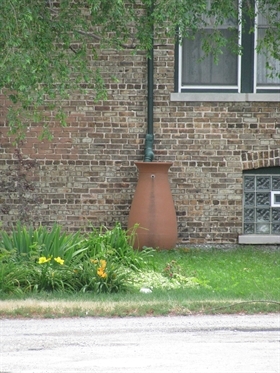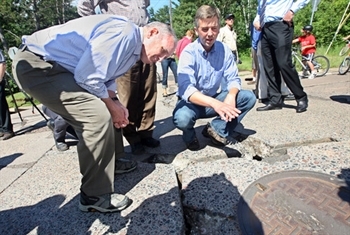
Derek Montgomery/Minnesota Public Radio
As evident on a street in Duluth, aging infrastructure can't withstand extreme storms, but without repairs, even day-to-day issues like infiltration and inflow cause serious problems for communities.
This is my first post as the associate for the water resources program here at MPC and when I first sat down to write it, I thought I would kick it all off by explaining a little bit about my background. But then, wouldn’t you know it, last week, my hometown, Duluth, Minn., was plastered all over the news and blowing up Facebook and Flickr with images of the biggest flood to hit Northern Minnesota in nearly a century-and-a-half. Between seven and ten inches of rain fell in 24 hours—an event considered a 500-year flood with only a .20 percent chance of happening any given year—so I decided to write about that instead.

A polar bear and two seals, including Feisty pictured here, temporarily escaped Duluth's Lake Superior Zoo during the flood.
Ellie Burcar
I grew up in Duluth, which sits at the western tip of Lake Superior, and lived there for 15 years. It’s where I gained my appreciation for the Great Lakes and first became interested in water policy and education. Seeing the images of streets from my childhood torn through with sinkholes or filled with water rushing like rivers reminded me of just how vulnerable our communities can be, particularly in light of changing climate patterns. The U.S. Global Change Research Program predicts higher temperatures, increased precipitation in winter and spring, and more droughts, heat waves and floods here in the Midwest.
But we don’t have to just sit back and let it happen. There are smart things we can do to reduce risk and manage what Mother Nature throws at us.
While it’s not economically feasible for communities to build stormwater and wastewater systems to handle a 500-year-flood event like the one that devastated Duluth, local governments and private property owners can take steps to alleviate day-to-day stormwater issues. In support of our work to change state policy to support sustainable water practices, MPC is working with a number of communities to demonstrate best practices for implementing and funding stormwater management and green infrastructure at the local level.
In Chicago’s Logan Square neighborhood on the northwest side, an area particularly prone to localized flooding and basement backups, we are part of a team that is distributing Illinois Green Infrastructure Grant dollars to property owners doing green infrastructure projects on their properties as part of the Milwaukee Avenue Green Development Corridor project. Rain barrels, green roofs, green walls, permeable pavers—these are all strategies the public sector can encourage private property owners to adopt to help reduce stormwater impacts.

Rain barrels, like this nice-looking one in Blue Island, help keep water out of basements and sewer systems and provide free water to property owners to use on their lawns and gardens.
Matt Nichols
In the City of Blue Island in south Cook County, we are partnering with the City, Illinois Dept. of Natural Resources’ Millennium Reserve, Metropolitan Water Reclamation District (MWRD), Cook South Suburban Master Gardeners, Illinois-Indiana Sea Grant’s Lawn to Lake program, and many other local organizations for the Blue Island Rain Barrel Project. The project is the first step toward addressing localized flooding and basement backup issues through an unprecedented installation of 1000 rain barrels and a handful of public rain gardens in one northeast neighborhood. On a Saturday in October, volunteers will help property owners disconnect downspouts, install rain barrels, and plan for backyard rain gardens.

Duluth Mayor Don Ness, pictured with Minn. Governor Mark Dayton, has been working to improve infrastructure and other services.
Bob King/Duluth News Tribune
It’s one thing to do green infrastructure at the hyperlocal scale of someone’s backyard, but it’s another to invest in smart, efficient infrastructure at the municipal scale. Back in March, MPC hosted a Gary and Region Investment Project Urban Exchange event featuring Duluth Mayor Don Ness and Gary, Ind. Mayor Karen Freeman-Wilson. One of the many things that struck me about the improvements he’s making in Duluth was the city’s investment in sanitary sewer overflow tanks to reduce their sanitary sewer overflows into Lake Superior.
Unlike Chicago, which has problems with combined sewer overflows, Duluth’s sanitary sewers are separate from the stormwater sewers but get inundated with stray water because of inflow and infiltration problems (similar to the problems noted in our recent report on recommendations for integrated water resources planning in Lake Zurich). Though Duluth’s sanitary sewer overflow tank failed during this extreme storm, it has held up through all the other major storms this season. Investments like this that repair and enhance broken and aging infrastructure combined with incentives for innovative green infrastructure will help communities weather uncertain climate conditions in the future.
All that said, stormwater is maybe the last thing people are worried about here in the Chicagoland region. This whole area, from southeastern Wisconsin through northeastern Illinois and northwest Indiana, is officially experiencing a moderate drought. Stay tuned for my next post, where I’ll continue on the theme of weather disaster preparedness planning and explain regional drought issues and the work MPC is doing with the Northwest Water Planning Alliance on water conservation and regional water supply management.